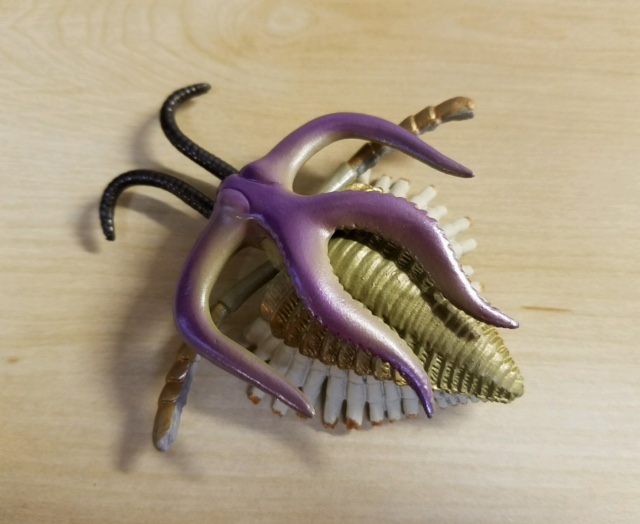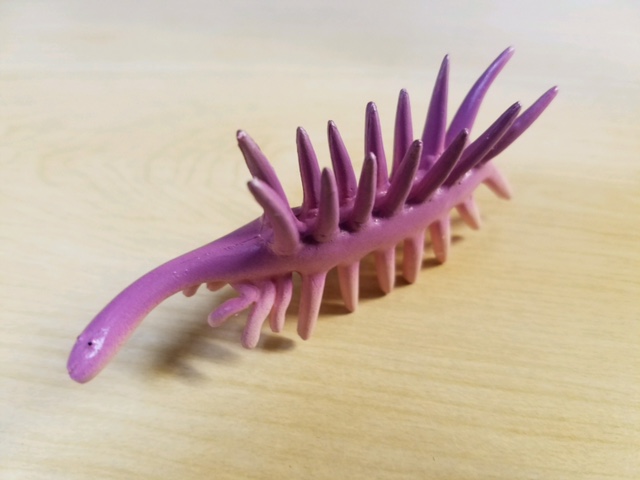Review and photos by bmathison1972, edited by Suspsy
Today, we will be looking at an overview of the Cambrian Creatures Mini Model collection released by Favorite Co. Ltd. in 2016. It consists of eight smaller models representing primarily Cambrian invertebrates along with one chordate. All the species presented have been found in the Burgess Shale deposits in North America. For a while, Paleozoic invertebrates were rare as toys and figures until about 2014 when they started hitting the market with some frequency. Most were made by Favorite, Kaiyodo, and Colorata, in various sets and scales. After 2017, things started to calm down a bit. When this set was first released, it consisted of these eight figures and a ‘chase’ figure, which was a yellow version of the Anomalocaris. I never had that figure (see below), so it will not be presented at this time. The figures are all solid PVC with no assembly required. Three come with bases from which they can be removed. Several of the figures are painted in bold colors that were certainly not natural.

First up, Marella splendens. For being one of the most common fossil, if not the most common fossil in the Burgess Shale deposits, this species is unique as a toy. The evolutionary relationships of this enigmatic arthropod are unclear. Originally described as a trilobite, it does not appear to fall into Trilobitomorpha, Chelicerata, nor Crustacea. The actual animal was small, roughly 2.0 cm in length. This figure has a body length of 6.0 cm for a scale of 3:1 (total length, including antennae, 8.0 cm). The figure is painted with faint iridescence to it, which apparently the animal had. The figure has 18 branched segments, which is a few shorter than the average than a mature specimen, and the second, smaller pair of antennae are lacking. Otherwise, the sculpt is pretty good for an animal with such an unusual morphology.

Second, we will look at the trilobite Olenoides serratus, which has become the go-to trilobite species for manufacturers to produce as of late. O. serratus is probably popular to make since it was common in Burges Shale deposits and is one of a handful of trilobite species with evidence of soft-tissue preservation, so we have a good idea what it looked like. The figure has a body length of 7.0 cm (total length, with appendages 11.0 cm), for a scale within the range of 1:1 (max. length roughly 9.0 cm). The figure has 15 pairs of appendages, which is in line with the species, although it is hard to tell which body region each are associated with. Small dorsal spines are present on each segment. This is a nice figure, as are the slightly smaller 2017 figure by Colorata and the 2020 articulated figures by Takara Tomy A.R.T.S.

Our next figure is another ‘standard species’ when it comes to prehistoric invertebrates, the dinocarididan Anomalocaris (presumed A. canadensis). This is one of the three figures that comes with a base. When the set was first released, there were two versions of this figure: this one and the aforementioned chase figure that was the same sculpt but painted yellow. Initially, I didn’t get the yellow figure, but later at some point I ordered it. Unfortunately, it was either stolen off my porch in Atlanta or got lost in the mail. Oh well, bottom line is I do not have it (and at this point, I doubt I will pursue it). The figure has a body length of 7.0 cm, putting it in the scale of about 1:14. The sculpt is not entirely accurate. It is lacking the head sclerites and the number of lateral flaps is wrong. There should be 19 total: 3 on the neck, 13 on the trunk, and 3 on the tail. The tail is correct, but there are only 13 total in the rest of the body (and there is no clear demarcation of which are on the neck and which are on the trunk). The oral cone looks good, however. There is no shortage of Anomalocaris figures to choose from. The 2015 Kaiyodo Great Leap Forward and 2017 Colorata figures are very nice, but the original 2001 Kaiyodo Dinotales figure may be the most accurate in terms of side flaps. The 2020 Takara Great Old Sea figure is nice too but is larger and articulated. Most figures except for the 2001 Dinotales and 2020 Takara versions appear to lack the three pairs of neck flaps.

The fourth figure in the set is Hallucigenia sparsa, an enigmatic onychophoran from the Burgess Shale. This, to the best of my knowledge, is the first figure of showing the modern concept of this species. Earlier figures (such as those by Kaiyodo and COG Ltd.) depicted H. sparsa in the classic, yet now outdated, restoration that turned out to be upside-down and backwards! What was a ‘head’ is now believed to be a stain blob. What was the tail is now the head. The dorsal tentacles were actually the legs and the stiff legs are really dorsal spines! Favorite’s updated figure also shows the tiny eyes and oral opening. The figure has a body length of 7.5 cm putting it at about 2.5:1-15:1 in scale. It is painted pink which was probably to add diversity to color in the set. If you want a modern depiction of Hallucigenia, this is the best option (unless you want to shell out money for the Trilobiti model).

The next figure we will be looking at is another go-to species these days, along with A. canadensis and O. serratus. I am referring to the unusual dinocarididan, Opabinia regalis. This is another figure that comes with a snug-fitting, yet removable, base. The total length of the figure is 9.0 cm. Minus the proboscis, the body is 7.0 cm, for a scale from 1:1.75 up to 1:1 for a large specimen. The number of gills, legs, ‘tail’ flaps, and eyes are all correct. The figure is painted green with red eyes and a black tip to the proboscis. It is believed O. regalis behaved somewhat like an elephant, whereby the proboscis would pick up food and deliver it to a mouth below the head. Not a whole lot more to say about this. Opabinia regalis is fairly well-represented in the toy/figure market these days, with several good ones to choose from. This one is nice, but if you want something smaller, the two by Kaiyodo are nice as is the one by COG. A year before this figure came out, Favorite released a larger ‘soft model’ version of O. regalis that is mostly blue in color.

The next figure is the one I was most excited about, the enigmatic Canadaspis perfecta. The phylogenetic position of C. perfecta is far from established. Historically, it was believed to be a crustacean, but now it is placed in Hymenocarina, which are considered stem-crustaceans. Canadaspis perfecta fossils are known from the Burgess Shale formations of North America with a sibling species, C. laevigata, known from Maotianshan Shale formations of Yunnan, China. The figure is 7.3 cm long with a carapace of 5.0 cm long, making it about 1.4:1 in scale for a large specimen. The number of legs and abdominal segments is correct, as is the presence of two pairs of antennae and eyes on stalks. A must-have for collectors of interesting and unusual taxa.

Our last two figures are the two non-arthropods in the group. First up is Wiwaxia corrugata, another common component of the Burgess Shale. Like many of these critters, the phylogenetic placement is not resolved. Most commonly, Wiwaxia is allied with the mollusks. The figure is 4.8 cm long, within the scale of 1:1. The formation of the sclerites and spines seem accurate; the latter is found in larger specimens suggesting they develop with age. There are a few examples of Wiwaxia on the market, and while you can’t go wrong with any of them, this might be the best. The ROM figure is nice but harder to find and the Yowie figure is too wildly painted (at least for my tastes).

The last figure is the one that is closest in relation to us, the chordate Pikaia graciliens. The figure comes with a base and measures 11.0 cm along the midline, for a scale of about 1:3. The figure is sculpted with graceful contours, as if swimming in the open water. It is mostly white with pink highlights on its appendages, the function of which is anyone’s guess at the moment (maybe for sensory purposes or to aid in filter feeding). Like the other two with bases, the figure can be removed and be displayed free of its base. There are a couple other figures of this species made by commercial manufacturers, such COG and ROM, but this is probably the best.
Well, there we have it, a review of the complete Cambrian Creatures Mini Model collection by Favorite. If you are a collector of unusual prehistoric taxa, this one set can knock out eight exemplars. For some, there may be slightly better versions, but since these are all speculative reconstructions, you can’t go wrong with anything from this set.
Support the Dinosaur Toy Blog by making dino-purchases through these links to Ebay and Amazon. Disclaimer: links to Ebay.com and Amazon.com on the Dinosaur Toy Blog are often affiliate links, when you make purchases through these links we may make a commission

I am so glad to see this set finally reviewed here. Fantastic job covering everything too. I really hope Favorite does another set like this as well, featuring on other Paleozoic animals, particularly on a formation, as they did with this set.
The best Cambrian wildlife figures on the market to date, no prehistoric toy animal company can compare in genius to Favorite when it comes to making Cambrian animals. Highly recommended.
Wow, it’s been that long?
This is a lovely set that deserves a second part!
Great review.
This set is so great. I keep hoping Favorite will put out more like it, ideally sculpted by Hirokazu Tokugawa.